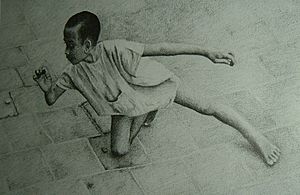Pitching pennies facts for kids
Pitching Pennies, also known as Pigeon Toss or Pitch and Toss, is a fun game played with coins. Players take turns throwing a coin towards a wall. The goal is to get your coin to land closest to the wall. The player whose coin is nearest to the wall usually wins! This game has many different names around the world, like Pap or Penny Up in Britain, Keeley in Scotland, and Nippy in Wales.
This game is very old. People have been playing it for a long time! Even children in Ancient Greece played a similar game using bronze coins. In modern Israel, people sometimes play a version of this game using Apricot kernels instead of coins. They call their game "Gogoim".
Contents
How to Play Pitching Pennies
Setting Up the Game
Any number of players can join in. First, everyone stands a set distance away from a wall. Each player needs one coin, usually a common type like a penny or a quarter.
Throwing the Coin
Players take turns throwing their coins towards the wall. The main goal is to make your coin land as close to the wall as possible. It's important that you throw the coin; rolling it along the ground is not allowed. In some versions of the game, your coin must actually hit the wall to count as a good throw.
Winning the Game
In many versions of Pitching Pennies, the player whose coin lands closest to the wall wins all the coins thrown by the other players.
There are also other ways to play:
- The "Tips" Game: The player whose coin is closest to the wall collects all the coins. They shake them in their hands and then toss them into the air. Before the coins land, this player quickly shouts "heads" or "tails". They get to keep all the coins that land facing the way they called. If any coins are left, the player whose coin was second closest to the wall gets to try next. This continues until all coins are picked up. This way, even if your coin wasn't the closest, you might still win some coins!
- Stacking Coins: Sometimes, a tossed coin might land right on top of another coin that was already closest to the wall. If this happens, the player whose coin is on top might win, even if their coin is further from the wall than the one underneath. However, if another player then throws a coin even closer to the wall than the stacked coins, that new coin becomes the one to beat.
What Happens in a Tie?
Sometimes, two or more coins might land exactly the same distance from the wall, or even touching it. When this happens, the rules can vary:
- Some rules say the game is a tie, and everyone gets their own coin back.
- Other rules say the players with the tied coins win and share the other coins. This can sometimes be tricky if the coins can't be divided evenly.
It's always a good idea to decide on the rules before you start playing!


